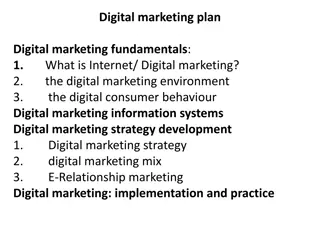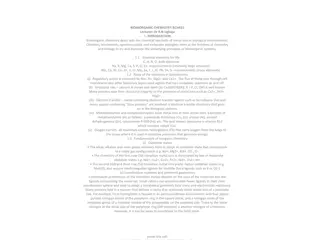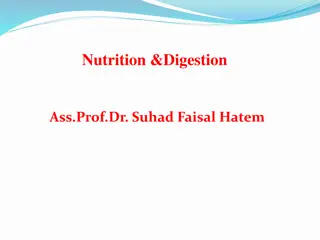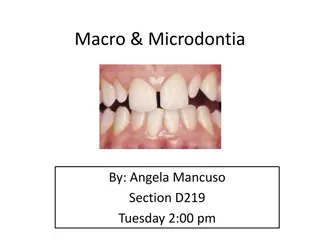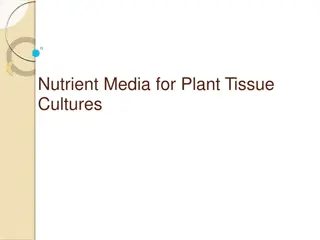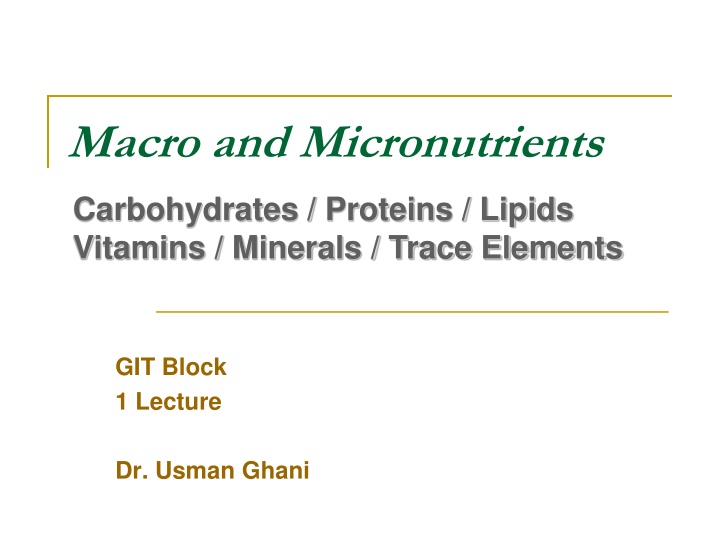
Macronutrients and Micronutrients in Nutrition
Explore the importance of macronutrients (carbohydrates, proteins, lipids) and micronutrients (vitamins, minerals, trace elements) in maintaining optimal health, energy provision, and disease prevention. Learn about the energy content of food, acceptable macronutrient distribution range, and the nutritional significance of proteins in the human diet.
Download Presentation

Please find below an Image/Link to download the presentation.
The content on the website is provided AS IS for your information and personal use only. It may not be sold, licensed, or shared on other websites without obtaining consent from the author. If you encounter any issues during the download, it is possible that the publisher has removed the file from their server.
You are allowed to download the files provided on this website for personal or commercial use, subject to the condition that they are used lawfully. All files are the property of their respective owners.
The content on the website is provided AS IS for your information and personal use only. It may not be sold, licensed, or shared on other websites without obtaining consent from the author.
E N D
Presentation Transcript
Macro and Micronutrients Carbohydrates / Proteins / Lipids Vitamins / Minerals / Trace Elements GIT Block 1 Lecture Dr. Usman Ghani
Overview What are macro and micronutrients? Types Functions Sources and RDAs Diseases and conditions due to their deficiency
Macronutrients Nutrients needed by the body in large amounts (proteins, carbohydrates, fats) They provide energy and building blocks for proteins, carbohydrates and fats Micronutrients Nutrients needed by the body in small amounts (vitamins, minerals, trace elements) Required for maintaining normal health and preventing various diseases They do not provide energy
Energy Content of Food Body obtains energy as ATP ATP is used for all body functions The energy content of food is measured in calories (Kilocalories) One calorie is the heat required to raise the temperature of 1 gm. of water by 1oC Proteins 4 kcal/gm Carbohydrates 4 kcal/gm Fat 9 kcal/gm
Acceptable Macronutrient Distribution Range (ADMR) Adequate intake of macronutrients to prevent the risk of disease AMDR for adults: CHOs: 45-65% Proteins: 10-35% Fats: 20-35%
Nutritional Importance of Proteins nitrogen for the body Essential amino acids : Body can t synthesize, must be supplied in the diet PVT TIM HALL: Pheylalanine, Valine, Tryptophan, Threonine, Isoleucine, Methionine, Histidine, Arginine, Lysine, Leucine Non-essential: body can synthesize Proteins supply amino acids and amino
Nutritional Quality of Proteins A measure of a protein s ability to provide the essential amino acids required for tissue maintenance Measured in PDCAAS units (Digestibility-Corrected Amino Acid Scoring) High value indicates more digestibility and high quality (maximum score 1.0) Proteins from animal sources: 0.82-1.0 Proteins from plant sources: 0.4
Sources and RDA Sources and RDA: Meat, poultry, fish, milk, wheat, corn, beans, nuts RDA (gms/kg body weight) Normal adults: 0.8 Athletes: 1.0 Pregnancy / lactation: upto 30 Children: 2.0
Nitrogen Balance Normal Nitrogen Balance In a healthy person, the nitrogen intake is equal to nitrogen loss Negative nitrogen balance When nitrogen loss is more than intake Occurs in burns, trauma, illness, metabolic stress Positive nitrogen balance When nitrogen intake is more than loss Occurs in growth, pregnancy, lactation, recovery from illness
Protein-Energy Malnutrition Malnutrition: A condition or disease caused by not eating enough food or not eating a balanced diet Malnutrition due to inadequate intake of proteins or energy Two conditions: Marasmus Kwashiorkor
Marasmus Kwashiorkor Inadequate intake of energy with adequate protein intake Inadequate intake of proteins with adequate energy intake Cause 1-3 year Mother s milk is supplemented with food (cereals) deficient in calories Arrested growth Extreme muscle wasting Weakness Weight loss No edema or changes in plasma proteins After weaning (at about 1 year) Diet mainly contains CHOs Age and food intake Edema Distended abdomen Diarrhea Dermatitis / thin hair Enlarged fatty liver Low plasma albumin Symptoms
Carbohydrates Their major role in diet is energy production RDA: 130 grams/day for adults and children Types in the diet: Simple CHOs: sucrose, fructose, lactose, corn syrup Complex CHOs: whole grains, pasta, wheat, starch CHO intake above RDA causes weight gain or obesity due to increased fat storage in adipose tissue
Protein-Sparing Effect Dietary protein requirement and CHO diet are related to each other CHO have protein-sparing effect They inhibit gluconeogenesis from amino acids That way amino acids are used for repair and maintenance of tissue protein and not for gluconeogenesis If CHO intake is less than the RDA (130 g/day) more proteins will be metabolized more gluconeogenesis will take place
Dietary Fiber The component of food that cannot be broken down by human digestive enzymes RDA (gm/day): Men: 38, Women: 25 Benefits: Lowers serum LDL levels Reduces constipation Promotes feeling of fullness Slows gastric emptying (long-term glucose control in patients with diabetes mellitus) Reduces exposure of gut to carcinogens
Fats in the Diet A concentrated source of energy (9 kcals/gram) Supply essential fatty acids such as linoleic and linolenic acids Provide phospholipids for membrane function Source of fat-soluble vitamins (A, D, E, K) and help in their absorption RDA (gm/day): Total fats: 65, Saturated: 20 Excessive fat intake can cause Atherosclerosis/heart disease Obesity
Essential Fatty Acids Two essential fatty acids: -linolenic acid ( -3 fatty acid) linoleic acid ( -6 fatty acid) Deficiency causes: scaly skin, dermatitis, reduced growth (most common in infants) Used for eicosanoids synthesis which appear to have cardioprotective effects decrease blood clotting decrease blood pressure
Omega-3 Fatty Acids Mainly found in cold-water ocean fish such as: albacore, mackerel, salmon, sardines, tuna, whitefish Play an important role as: Structural membrane lipids Modulator of -6 fatty acid metabolism
Recommendations for Omega-3 Fatty Acid Intake American Heart Association Guidelines Population Patients without coronary heart disease (CHD) Recommendation Fatty fish twice a week Include oils and foods rich in -linolenic acid (flaxseed, canola and soybean oils; flaxseed and walnuts) --------- 1 gm of EPA+DHA per day from fatty fish EPA+DHA supplements --------- 2 to 4 grams of EPA+DHA per day Patients with CHD Patients who need to lower triglycerides (fats)
Omega-6 Fatty acids Nuts Avocados Olives Soybeans Oils (sesame, cottonseed, corn oil) Sources Plasma cholesterol LDL HDL Effects
Omega-3 Fatty acids Plants Fish oil containing docosahexaenoic acid (DHA) and eicosapentaenoic acid (EPA) Sources Suppress cardiac arrhythmias Serum triacylglycerols Tendency to thrombosis Lower blood pressure Risk of cardiovascular mortality Little effect on LDL or HDL levels Effects
Trans Fatty Acids Unsaturated fatty acids, behaving more like saturated fatty acids in the body increase serum LDL (but not HDL) risk of CVD Not found in plants (animals only) Formed during hydrogenation of liquid vegetable oils Found in baked food: cookies, cakes, deep-fried foods
Vitamins Organic compounds present in small quantities in different types of food Help in various biochemical processes in cell Important for growth and good health Essential Noncaloric Required in very small amounts
Vitamins - Classified Based on Solubility Fat-Soluble Vitamins A, D, E, and K (stored in the body) Water-Soluble Vitamins Ascorbic acid (vitamin C) Thiamin (vitamin B1) Riboflavin (vitamin B2) Niacin (vitamin B3) Pyridoxine (vitamin B6) Biotin Pantothenic acid Folate Cobalamin (vitamin B12)
Vitamin D (Calciferol) Synthesized either from 7-dehydrocholesterol or ergosterol by UV light Considered a hormone, can be synthesized by the body Maintains calcium homeostasis, healthy bones and teeth Promotes calcium/phosphorous absorption from the intestine Increases bone mineralization
Vitamin D Sources and RDA (IU) Sunlight, fish, egg yolk, milk Adults and Children: 600 Deficiency causes: Rickets: Insufficient bone mineralization in children Bones become soft and deformed Osteomalacia: Bone demineralization and increased osteoporosis Painful bones with frequent fractures
Vitamin E Antioxidant: prevents oxidation of cell components by molecular oxygen and free radicals May have a role in fertility and anti-aging effect - tocopherol is the most active form in the body Sources and RDA (mg/day): Vegetable Oil, nuts, seeds, vegetables Adults: 15, Children: 7 Deficiency: (mostly observed in premature infants) Defective lipid absorption Anemia due to oxidative damage to RBCs Neurological problems Male infertility
Functions of Vitamin B1 (Thiamin) Active form: Thiamin pyrophosphate (TPP) Coenzyme for transketolase and oxidative decarboxylation reactions In thiamin deficiency, the activity of these two dehydrogenases is decreased Causing: Low ATP production and defective cellular function Sources and RDA (mg/day) Plants, cereals, meat Adults: 1.2, Children: 0.6
Disorders of Vitamin B1 (Thiamin) Deficiency Beriberi A type of chronic peripheral neuritis due to severe thiamin deficiency causes weakness, neuropathy, disorderly thinking, paralysis Thiamin has a role in nerve conduction Neuropathy affects glial cells (astrocytes) of the brain and spinal cord causing neuron death Wernicke-Korsakoff syndrome Common in alcoholics due to defective intestinal absorption of thiamin or dietary insufficiency Causes apathy, loss of memory
Functions of Folic Acid Folate: natural / Folic acid: synthetic form Essential for synthesis of many compounds Important in one-carbon metabolism Transfers one-carbon units to intermediates, amino acids, purines and thymine Helps prevent cancer and heart disease Sources and RDA ( g/day): Green leafy vegetables, lentils, peas, beans Adults: 400, Children: 150-200, Pregnancy: 500-600
Disorders of Folic Acid Deficiency Megaloblastic anemia Anemia with larger RBCs Deficiency in pregnancy and lactation due to increased demand Poor intestinal absorption due to alcoholism or drugs Neural tube defect Folic acid supplementation in early pregnancy reduces the risk of neural tube defect in fetus
Functions of Vitamin C Powerful antioxidant (prevents some cancers) Helps in dentine, intercellular matrix and collagen formation Increases iron absorption Helps in the maturation of RBCs Promotes wound healing Stimulates phagocytic action of leukocytes Reduces risk of cataract formation
Disorders of Vitamin C Deficiency Sources and RDA (mg/day): Citrus fruits, tomatoes, melon, peppers Men: 90, Women: 75, Children: 15-25 Deficiency: Scurvy Abnormal collagen production Gums become painful, swollen and spongy The pulp is separated and the teeth are lost
Scorbutic gums in vitamin C deficiency. Gums are swollen, ulcerated, and bleeding due to vitamin C-induced defects in oral epithelial basement membranes and periodontal collagen fiber synthesis.
Minerals and Trace Elements Microminerals (<100 mg/day) Iron Iodine Copper Manganese Zinc Cobalt Macrominerals (>100 mg/day) Calcium Phosphorous Sodium Potassium Chloride Magnesium Molybdenum Selenium Fluoride Chromium Silicon
Calcium Functions Bone growth and teeth formation Neurotransmission of nerve impulse / muscle function Blood coagulation / activates enzymes Sources and RDA (mg/day): Mainly dairy products (milk, yoghurt, cheese) Men: 1000, Women: 1200, Children: 700- 1300 Calcium deficiency: Rickets, osteomalacia, osteoporosis
Iron Functions Oxygen transport and metabolism Part of hemoglobin, myoglobin, cytochromes Body stores iron as ferritin, hemosiderin and transferrin Adult women have much lower iron storage than men Sources and RDA (mg/day): Heme iron: Animal products (meat, liver), 25% absorption Nonheme iron: Plants (spinach, beans), 5% absorption Men: 8, Women: 18, Children: 7-15
Iron Deficiency Iron deficiency anemia is most common Growing children, pregnant, lactating and menstruating women need more iron Hemosiderosis (iron overload disorder) Due to iron excess (toxicity) Hemosiderin (Iron stored in complex with ferritin protein in liver and spleen) Occurs in persons receiving repeated blood transfusions
Iodine Dietary iodine is stored in thyroid gland for thyroid hormone synthesis Tri-iodo-thyronine (T3) and thyroxine (T4) Sources and RDA ( g/day): Dairy products, seafood, fortified salt Adults: 150, Children: 90 Iodine deficiency: Cretinism: deficiency of thyroid hormones in children causes stunted physical and mental growth Goiter: enlargement of thyroid gland due to iodine deficiency affecting thyroid hormone synthesis

